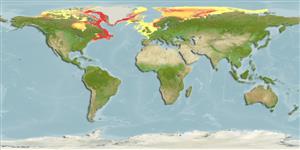Environment: milieu / climate zone / depth range / distribution range
Ecologie
marien bathydemersaal; diepte 18 - 930 m (Ref. 117245). Deep-water; -1°C - 4°C (Ref. 13534); 83°N - 41°N, 139°W - 141°E (Ref. 117245)
Western Atlantic: western Greenland (Ref. 4695), Hudson Bay and Labrador to Massachusetts (Ref. 7251). Arctic: west of Boothia Peninsula in the Northwest Territories (Ref. 3814) and the northern parts of Kara and Laptev seas (Ref. 4695).
Grootte / Gewicht / Leeftijd
Maturity: Lm ? range ? - ? cm
Max length : 36.0 cm TL mannelijk / geslacht onbekend; (Ref. 7251)
Occurs on soft bottoms (Ref. 13534). Benthic (Ref. 58426). Feeds mainly on epibenthic animals and does not seem to burrow much for prey. Smaller fish prey on smaller species like amphipods, isopods and small bivalves while larger fish prey on shrimps, euphausiids and fish (Ref. 13532).
Levenscyclus en paargedrag
Maturiteit | Voortplanting | Paaien | Eieren | Fecunditeit | Larven
Anderson, M.E., 1994. Systematics and osteology of the Zoarcidae (Teleostei: Perciformes). Ichthyol. Bull. J.L.B. Smith Inst. Ichthyol. 60:120 p. (Ref. 11954)
Status op de Rode Lijst van het IUCN (Ref. 130435: Version 2024-1)
Gevaar voor de mens
Harmless
Gebruik door de mens
Tools
Speciale rapporten
Download XML
Internetbronnen
Estimates based on models
Preferred temperature (Ref.
123201): 1.4 - 7.1, mean 3.5 °C (based on 213 cells).
Fylogenetische diversiteitsindex (Ref.
82804): PD
50 = 0.5000 [Uniqueness, from 0.5 = low to 2.0 = high].
Bayesian length-weight: a=0.00309 (0.00192 - 0.00496), b=3.21 (3.07 - 3.35), in cm total length, based on LWR estimates for this species & Genus-body shape (Ref.
93245).
Trofisch niveau (Ref.
69278): 3.5 ±0.53 se; based on food items.
Weerstandsvermogen (Ref.
120179): laag, minimale populatieverdubbelingstijd 4,5-14 jaar (Preliminary K or Fecundity.).
Fishing Vulnerability (Ref.
59153): Low to moderate vulnerability (26 of 100).
